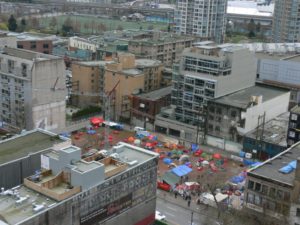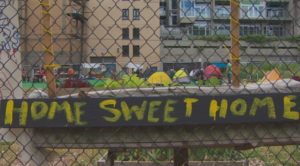
Why we have homelessness
You have to be old to remember this: we didn’t always have a lot of homelessness in Canada.
When I worked at the Downtown Eastside Residents Association in Vancouver in the 70s we worked on getting a community centre open, stopping tax buyers from ripping people off, getting sprinklers in single room occupancy hotels. We didn’t work on homelessness because it wasn’t a huge problem in Vancouver. There were no homeless counts then so I can’t tell you exactly how many homeless people there were but my estimate is about one tenth of the 2,138 counted on the streets in Vancouver in 2017 (there are really a lot more than that).
I think there are three factors that have created our current homeless crisis: not enough social housing units are being built that low-income people can afford, welfare isn’t high enough to pay rent and eat, and SRO hotels, the last resort before homelessness, are being gentrified.

Governments stopped building enough social housing
In the 70s and 80s governments built hundreds of units of social housing a year, just in Vancouver. The average number of social housing units per year that opened in Vancouver throughout the 1980s was 767. And in those days low-income people could afford to live in social housing. Rents were set at the welfare shelter allowance, or 30% of your income. Nowadays governments have changed the definition of social housing so most of it excludes low-income people. A study by the Mainlander last year found that low-income people could afford fewer than 10% of Vancouver’s new social housing units. Between 2007 and 2014 the province opened about 200 units of new social housing a year in Vancouver that low-income people can afford – not nearly enough.
Welfare purchasing power fell and welfare became harder to get
Those on welfare who can’t get into social housing have to live in private, market housing; but rates are too low to pay market rents. In 1980, welfare had enough purchasing power that you could afford to pay rent AND eat. If welfare had the same purchasing power now that it had in 1980, it would be $984 per month, not the $610 it is today. In 2002, the Campbell Liberal government made welfare a lot harder to get. They made people wait three weeks between applying and receiving welfare and required people to prove that they had earned a certain amount of money for two years prior to applying. People in need simply can’t get on welfare.

SRO hotels got gentrified
And back in the 70s and 80s, if you couldn’t get into social housing and couldn’t afford market rent, you could always find a single room occupancy hotel room to rent as a last resort before homelessness. Mostly they cost the welfare shelter allowance. Today, the Carnegie Community Action Project says the average rent for a privately owned and run SRO hotel room, with no kitchen and a washroom down the hall is $548 a month, $163 a month more than the welfare shelter allowance, leaving people on welfare with $2 a day for food and everything else except rent.
Blaming victims for what government causes
While federal and provincial governments have been busy cutting back on life-saving social programs, their spin doctors have been busy churning out a thinking framework that blames the victims. In 1993, the Federal government basically stopped funding new social housing, with a few little exceptions. In 1996, the Federal Liberal government ended the Canada Assistance Plan which provided provinces with half the funds they needed for welfare. But when Gordon Campbell had to admit that homelessness was going up massively during his term, he set up a task force on “homelessness, mental health and addictions,” as though homelessness was caused by mental health and addiction issues rather than the lack of housing and the inability to afford it which his government, aided by the Feds, had created. People had mental health and addictions issues back in the 70s and 80s, but they also had housing and not a good income, but enough to pay rent and eat.
Ending homelessness is not rocket science. It doesn’t require elaborate studies, outreach workers, partnerships, and services. It requires taxing the rich to build housing and paying welfare rates that are high enough to live on.
